

Réseau PERT. Un article de Wikipédia, l'encyclopédie libre.
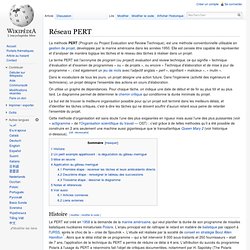
La méthode PERT (Program ou Project Evaluation and Review Technique), est une méthode conventionnelle utilisable en gestion de projet, développée par la marine américaine dans les années 1950. Elle est censée être capable de représenter et d'analyser de manière logique les tâches et le réseau des tâches à réaliser dans un projet. La méthode PERT. Le PERT (Program Evaluation and Revue Technique – Technique d’élaboration et de mise à jour de programme) a été créé en 1958, aux USA pour la planification du programme spatial POLARIS.
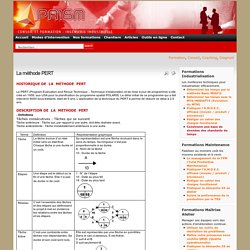
Le délai initial de ce programme qui a fait intervenir 9000 sous-traitants, était de 6 ans. L’application de la technique du PERT a permis de réduire ce délai à 2,5 ans. - Définitions Tâches consécutives : Tâches qui se suiventTâche antérieure : Tâche qui, par rapport à une autre, doit être réalisée avant.Tâche antécédente : Tâche immédiatement antérieure à une autre. Stoos Network (part 3): Core Idea. One wish I had for the gathering in Stoos was to discover a common foundation that could reconcile differences between the many management thinkers, writers and consultants the world has already generated before.
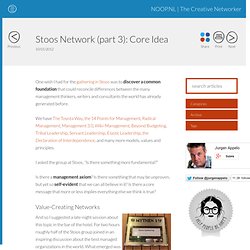
We have The Toyota Way, the 14 Points for Management, Radical Management, Management 3.0, Wiki-Management, Beyond Budgeting, Tribal Leadership, Servant Leadership, Elastic Leadership, the Declaration of Interdependence, and many more models, values and principles. I asked the group at Stoos, “Is there something more fundamental?” Is there a management axiom? Is there something that may be unproven, but yet so self-evident that we can all believe in it? Is there a core message that more or less implies everything else we think is true? Stoos Network (part 4): Name & Identity. Stoos Network (part 5): Complaints & Complexity. Hack Management 2.0. Management 3.0 - Management 3.0. Stoos Network - Home. Stoos Network (part 1): About Communication. I write this in my hotel room after having traveled back from Stoos to Zürich airport.
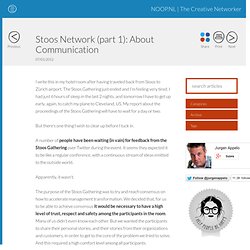
The Stoos Gathering just ended and I’m feeling very tired. I had just 6 hours of sleep in the last 2 nights, and tomorrow I have to get up early, again, to catch my plane to Cleveland, US. My report about the proceedings of the Stoos Gathering will have to wait for a day or two. But there’s one thing I wish to clear up before I tuck in. A number of people have been waiting (in vain) for feedback from the Stoos Gathering over Twitter during the event. Apparently, it wasn’t. The purpose of the Stoos Gathering was to try and reach consensus on how to accelerate management transformation.
And so, at the start of the event, we asked ourselves, “What about Twitter?” Then a long discussion started. Some of the participants had non-disclosure agreements with their organizations and/or customers. Personally, I would not have minded more openness to the outside world during the event itself. Stoos Network (part 2): Stakeholders & Personas. "Who is our customer?
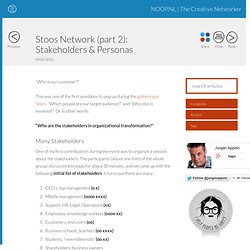
" This was one of the first questions to pop up during the gathering in Stoos. "Which people are our target audience?” And “Who else is involved? " Or in other words: "Who are the stakeholders in organizational transformation? " Many Stakeholders One of my first contributions during the event was to organize a session about the stakeholders. Results-Only Work Environment (ROWE) The Seven Sins of Solutions. Scenario planning framework and success factors - Ross DawsonKeynote speaker. Selection of Ross Dawson Frameworks Scenario Planning in Action Click on the image to see full-size pdf Below are summaries of the key points in the overview page: What is scenario planning?
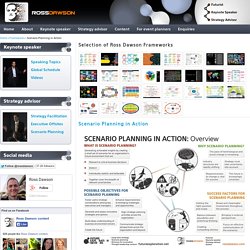
Generating insights by creating a small set of scenarios for an organization’s future environment that are: – Relevant to critical business decisions – Distinct – Individually realistic and believable – Together cover the breadth of relevant uncertainties Why scenario planning? Possible objectives for scenario planning – Foster useful strategic conversations among key executives and managers – Enhance responsiveness to emerging challenges and opportunities – Generate and assess innovative strategies and options – Align strategic planning activities across the organization – Build deep understanding of business environment drivers – Communicate strategic perspectives across the organization and beyond – Create the future Below are summaries of the key points in the example process:
The OR Society - Operational Research, at the heart of analytics. Learn About O.R. OR-Notes - contents. Tudumo : une todo-list entièrement contrôlable par raccourcis clavier (GTD, productivité) Est un logiciel de redoutablement efficace. Il combine les avantages du et de la méthode . Encore disponible en , il est déjà impressionnant par la richesse de ses fonctionnalités, sa convivialité et sa simplicité. Il rivalise très bien avec les à base de fichier texte et vous fera certainement oublier les applications web 2.0 de listes de choses à faire qui florissent ces temps-ci. D’autant plus qu’il est exécutable à partir d’une . Voici un petit tutoriel pour le découvrir… Installation Il vous faudra d’abord télécharger la version bêta de Tudumo .
Sachez que vous devrez avoir le version 2 minimum installé sur votre machine pour que fonctionne.